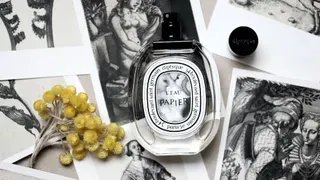June 25, 2012
'Huge Bear' Attacks EDGE Office!
Kilian Melloy READ TIME: 7 MIN.
Reading the title of this column, you're either thinking that one of the hibernating mammals of the ursus major, picnic-basket-stealing variety came prowling by EDGE; or, alternatively, you might be picturing one of those fellows who doesn't like to shave his face or body. Wrong on both counts.
From time to time, your humble columnist has a chance to attend wine tastings and write about them for EDGE. This led recently to an opportunity to bring a winemaker into the company's Boston-based home office for a private tasting of his vineyard's wares. The label was the delectably named Huge Bear winery. Owner Timothy Carl was in Boston to promote the label with local restaurants and wine shops.
Having attended Harvard, where he earned a Ph.D. in genetics, Carl has ties to Boston. His parents were vintners who saw their vines destroyed by blight; Carl moved away from the world of wine making for a time, and embarked on a career in the restaurant world, where he became a sous chef, giving him deeper insight into what makes for a great wine pairing with any given sort of dish. During his time in Boston, Carl saw his children grow into adults; the city is home to his family.
But Carl always had the intention of returning to the traditional family business, and now he and his wife not only cultivate a vineyard in California's Knights Valley. Carl is also part owner of the label. "I'm a sixth-generation grape grower," Carl told EDGE, "and she's a fourth-generation grape grower."
The EDGE staff loved the wine, but even more popular was the name emblazoned on the bottles.
"Where the name actually came from was, I was going through the archives of some old newspapers in the San Francisco area," Carl told the EDGE staff, who had assembled around the table in the office's conference room. "California started in the middle of the 1800s, and there was a group of settlers that lived in Knights Valley, and that's where I live; that's where the vineyards are. There was this headline that said, 'Huge Bear Attacks Knights Valley.' And I thought, 'Oh my gosh, that is it! That is the coolest name! Because it's perfect for what we're trying to do."
Attack Knights Valley?
"Well, in a way," Carl said with a smile, "because we're trying to make a wine that is bog and bold. But here is the other tie: back to the story about the settlers in Knights Valley. They banded together and formed this group to try to hunt that bear, but also they formed a group that raised the bear flag and started California. In my mind, these people are motivated by the independence of this bear raiding their food stories, and at the same time they took inspiration to become an independent state [from the bear].
"In addition to that, in the 1850s, my family went out to California from New York, and started planting grapes--apricots, grapes, and almonds. So I like the historic tie to the bear, which is huge in terms of its tie to California history and my family history. And I love the idea of biology, because the grizzly bears in California were brought to extinction in the 1880s. There were five different species of grizzly bear. What we do with the profits from Huge Bear is put that back into land restoration for wild natural habitats.
"I'm also a Californian," Carl continued. "I understand that Huge Bear has connotations in California. I grew up in San Francisco in the '60s, '70s, '80s. I love what California is about; I love the spirit and the fact that we are diverse. So when you taste the wine, I hope you get a lot of the historic, iconoclastic rebelliousness of the state. It's just fun."
In 2005, Carl and four business partners--three of whom are from Boston--started the label. They have maintained their Boston ties from the beginning. "We're at Fenway," Carl noted, "and we're at the Boston Bruins. And there are restaurants in the area that carry our wines, and a couple of new, really hip retail stores that are carrying us as well. We do hope to fain a following in Boston; California has really picked it up, and Canada also. New York is really going crazy for our wine. Texas is actually another place that's excite about Huge Bear. I think they like the bigness of it, and it's a nice tasting wine.
"Ultimately, what we're trying to do is make a wine that is delicious and approachable."
The soil and climate of any growing region will affect the resulting wine, EDGE noted; what would we be apt to notice when it came time to sample the wines?
"I think in general the great thing about wine is that wine shows the personality of a place," Carl mused. "When you drink wine you can drink it because it tastes good , but also, hopefully, on some level, you are also learning about the place that it comes from. It's telling you a story about the land. What I hope you are gong to taste what Knights Valley can do for both a Chardonnay and a Cabernet."
Carl expertly wielded the wine opener and had the Chardonnay open in a moment. "We only make few hundred cases of this," he told the assembled EDGE staff. "This is very, very rare.
"What we're going to taste with the Chardonnay is that is has a richness; it's got components of pear, apple, and lemon. It was done in French oak, so it's going to have some subtle oak to it," Carl added. "But it's gong to be creamy and delicious and have enough acidity that it can stand up to a meal. You should be able to drink wines on their own, but then you should also be able to drink them with a meal--wine shouldn't overwhelm the food, but should enhance it.
"My early career was in the food business, so I was sous chef at a bunch of different restaurants in California, and trained out in California and Italy," Carl added. "What I learned in the food world was that you have to really think about balance. Ultimately, everything I have done has tied into wine."
The Huge Bear Chardonnay comes from 18-year-old vines. Carl poured a glass of the 2009 vintage. "This Chardonnay should be really balanced," he said. "It should have some pear, apple, and lemon, not to mention some floral characteristics. It should be nice and smooth.
"When I'm thinking about wines, I'm thinking about what I call 'football wines,' " Carl added. "They cone into your mouth and they have a nice shape: They really spread out on the mid-palate, and then they tail off to this nice finish. That's what we're looking for. There should be some character, there should be something going on."
Accompanying notes he had provided noted, "The cool weather of 2009 resulted in a Chardonnay that is both crisp and complex."
Not to mention full-bodied and riotously delicious on the tongue. This is not a thin and spiritless Chardonnay, the sort of wine that gives Chardonnay a reputation for being vanilla (in the sense of the word that denotes the uninspired, the routine, and the mild). The wine's structure is complex, as promised, with a floral nose, an oaky foundation, a freshness that peaks of white fruit, and a fundamental richness that is both discreetly sweet and full of character.
The response from around the table was unanimous: "Wow!"
"Very ice, dry finish," added EDGE's company CFO appreciatively.
Like many chardonnays, the wine had something of a buttery character. "We also use French oak" for the casks, Carl said, "so there's oak in there, but not too much. This would really work with a fish dish," noted Carl. "What I'll do with this is take some line-caught salmon and then go to any lumber store and buy some plank-cut white oak, soak it in water overnight, put on your grill--not over the flame, but off to the side--then put the fish on top of that that and cover it up and oh, my gosh. The fish gets very tender, it picks up some subtle components from the wood, and it marries just perfectly with this wine."
The wine also carries a hint of hazelnut, Carl noted, before sharing another recipe for crusting halibut with hazelnut.
Several EDGE staffers mentioned that they were less fans of white then red wines. Carl reached for the bottle of Huge Bear Cabernet, sharing a bit more family lore as he did so. "My family used to ship grapes during Prohibition," he recounted. "You used to be able to make wine for church, or you could also make a barrel of wine for your own use during Prohibition. But my family had a lot of grapes, and the church could only use so much out in California, so they would send these big, huge shipments on the train. The family story is that on the side of the train it would say, 'Warning: Do not add one part yeast, one part sugar, one part water. If you do, you'll make wine.' That was the recipe for making wine, of course, and so when they would ship their grape harvest out here, it would get sold!"
The Cabernet, vintage 2008, is full-bodied and very dry, with a mineral character, and carrying just a hint of tannin. Dark red fruit characterizes the flavor; the finish is redolent of chocolate with a dark cherry aroma, and a trace of sandalwood, lending the finish a spicy, almost incense-like quality.
"The majority of this fruit comes from mountainside vineyards un Knights Valley," the press notes read. "The volcanic soils of this special place leads to complexity in both flavors and aromas while maintaining structure and balance." There were 250 cases of this wine produced; it retails for $55 per bottle.
"Very soft," one staffer murmured.
'Yeah, this wine is very soft," Carl agreed, going on to explain how the volcanic soil makes for "a very soft tannin." Added the winemaker, "It's got this brambly, blackberry thing going on. It's got that football quality. Do this when you're tasting wine: Think about where it is in your mid-palate. How does it feel? Is it very thin, or is it kind of chunky? That, to me, is such a great indication of balance. Sometimes you'll get this sharp think in the back, but you want it to be very smooth.
The EDGE staff gave Carl a bit of good-natured ribbing over the wine's built-in appeal to the GLBT community, or at least a certain subset of it. Carl, whose mother is now married to a female spouse, was earnest in noting that he was aware of this. "I am immersed in a bunch of communities," he said, "but what's exciting for me is to find people who are passionate about the wine."
That extends to the vendors and restaurateurs with whom the label conducts business: "Anyone modern, anyone story-oriented, concerned with cooking organically, people who care about where their food is coming from--people who care about what they are doing."
Kilian Melloy serves as EDGE Media Network's Associate Arts Editor and Staff Contributor. His professional memberships include the National Lesbian & Gay Journalists Association, the Boston Online Film Critics Association, The Gay and Lesbian Entertainment Critics Association, and the Boston Theater Critics Association's Elliot Norton Awards Committee.




